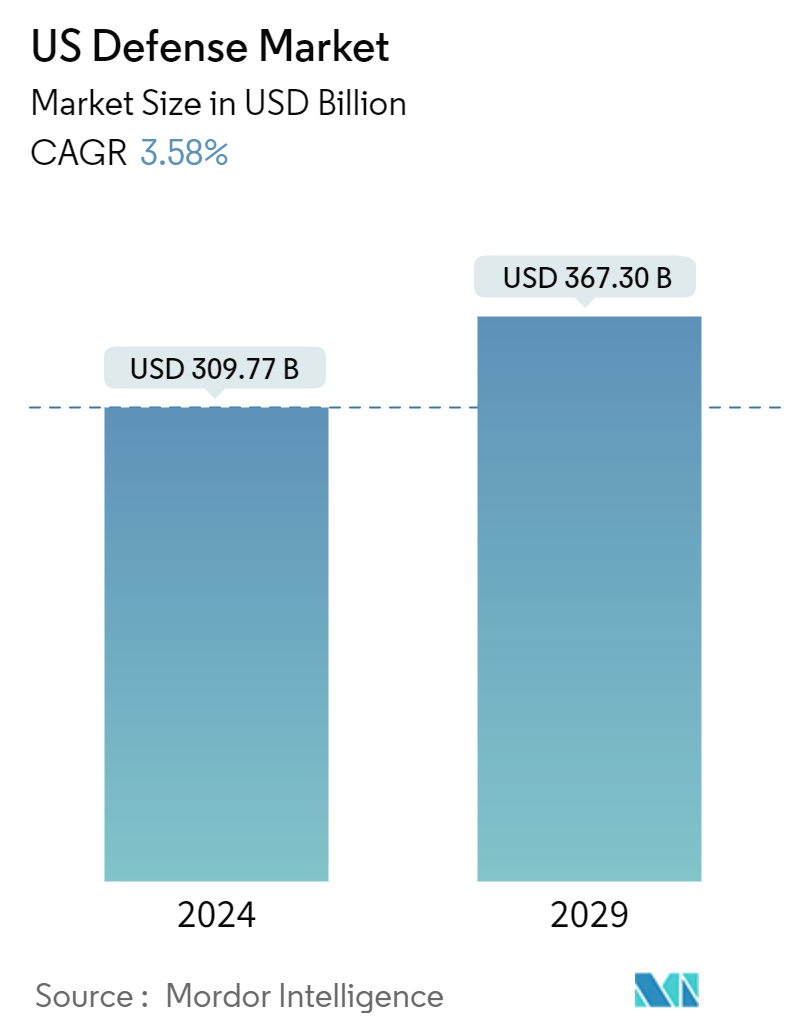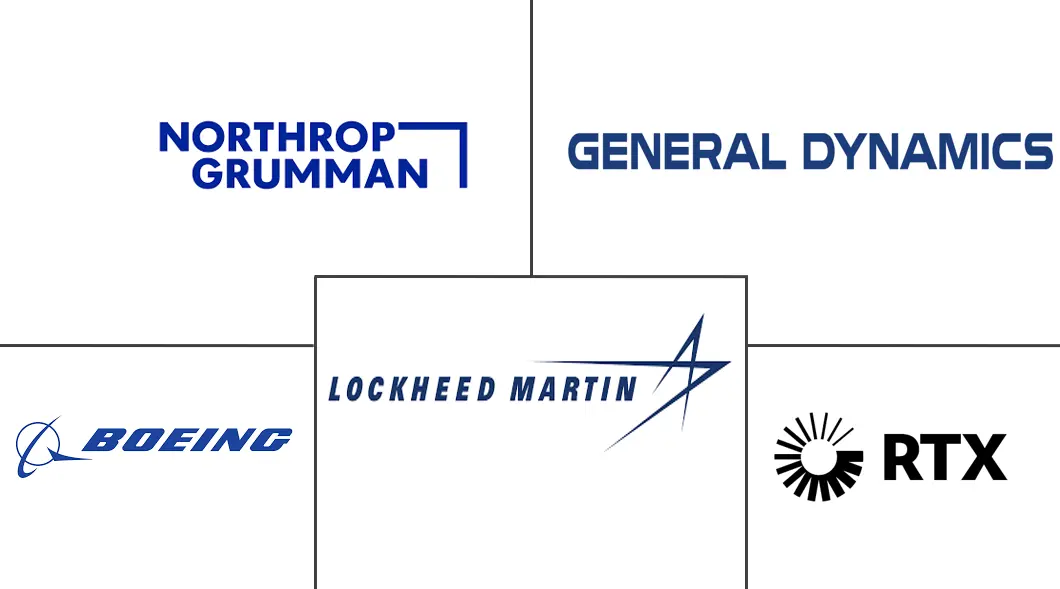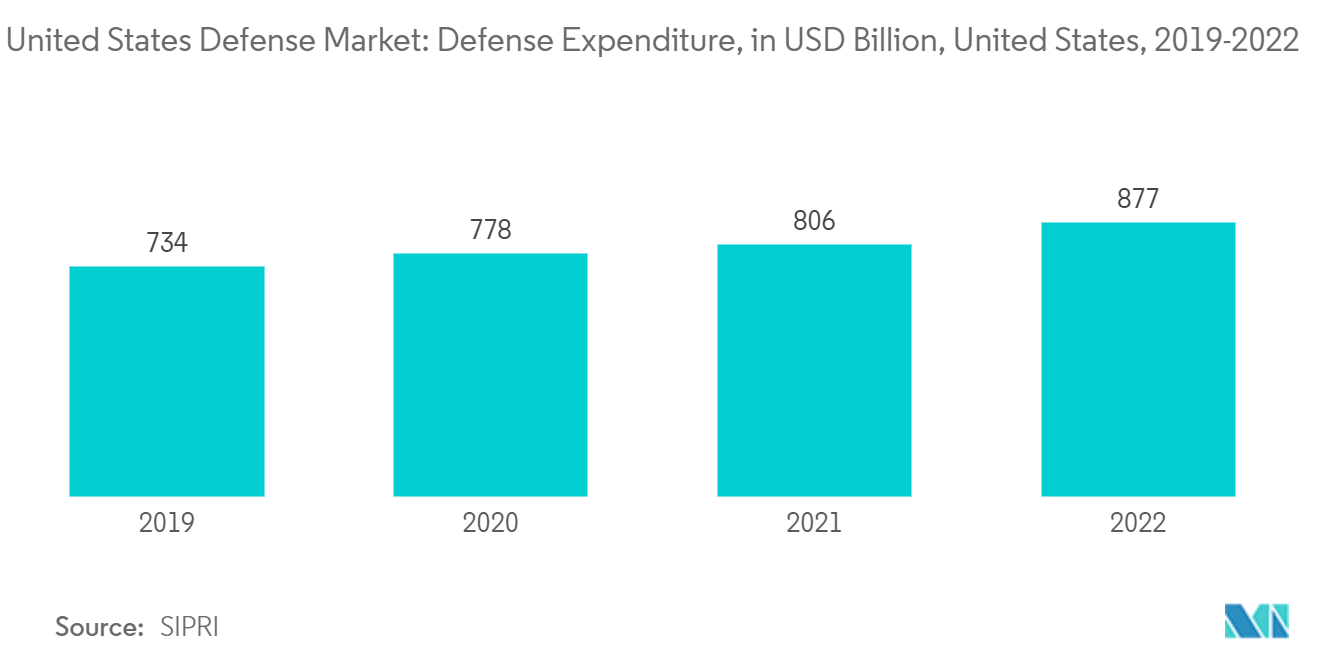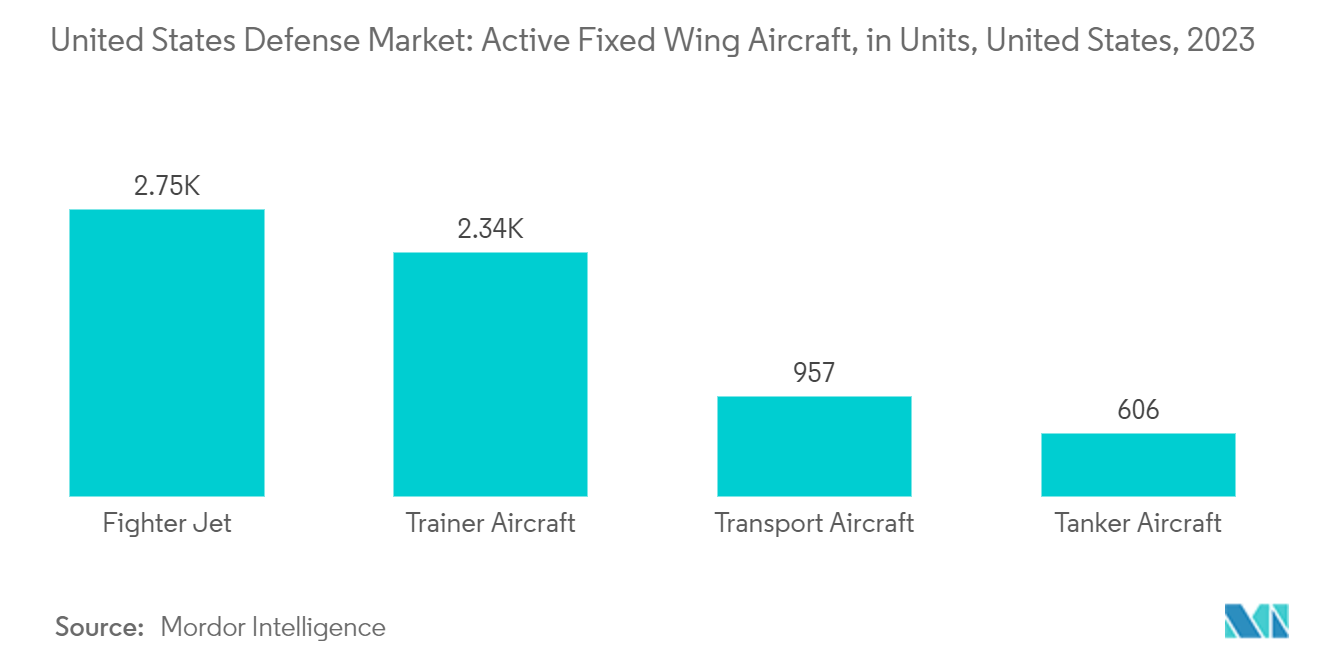US Defense Market Size

| Study Period | 2019 - 2029 |
| Base Year For Estimation | 2023 |
| Market Size (2024) | USD 309.77 Billion |
| Market Size (2029) | USD 367.30 Billion |
| CAGR (2024 - 2029) | 3.58 % |
| Market Concentration | Medium |
Major Players
*Disclaimer: Major Players sorted in no particular order |
US Defense Market Analysis
The US Defense Market size is estimated at USD 309.77 billion in 2024, and is expected to reach USD 367.30 billion by 2029, growing at a CAGR of 3.58% during the forecast period (2024-2029).
The US defense market is expected to grow primarily due to the armed forces' procurement and upgrade activities to counter emerging threats. Several contracts from the military, air force, and naval force are currently underway, and many new contracts are anticipated to be dispersed during the forecast period, creating a parallel demand for defense equipment.
The US military uses multiple aircraft for usage across Air Force and Navy. Owing to the increasing international conflict with China over its aggression in the South China Sea, the United States is gearing up to tackle any potential issues China may create for countries with close ties with the United States, like Taiwan and Japan. As a result, significant investments into upgrading the existing fleet and/or purchasing a new fleet equipped with efficient technologies have been witnessed over the past years.
While the US aerospace and defense sector stands on the cusp of significant growth, it faces formidable challenges in supply chain vulnerabilities. The industry's supply chains, often global and intricate, are susceptible to disruptions, as evidenced by the impact of the pandemic on production and logistics. In addition, the increasing integration of digital technologies and connectivity in defense systems opens up new fronts in cybersecurity risks. State-sponsored cyber threats targeting defense contractors and critical infrastructure are becoming more sophisticated, posing a serious concern. For instance, in 2022, the number of cybersecurity attacks on federal agencies in the US was 30,659.
However, addressing these challenges presents opportunities for resilience and innovation within the industry. Strengthening supply chain resilience through localized production and diversification strategies may mitigate risks associated with global disruptions. Simultaneously, investing in robust cybersecurity measures and collaboration with cybersecurity experts may fortify the industry against evolving cyber threats, ensuring the continued integrity of critical defense systems.
US Defense Market Trends
The Air Force Segment to Exhibit the Largest Market Share During the Forecast Period
The Air Force segment is expected to experience major growth in the US defense market due to various procurement plans for replacing aging combat aircraft and new unmanned aerial vehicles. The demand for this segment is driven by the annual investment in defense, towards bolstering its military capabilities to counter emerging threats. For instance, the US is the world's largest spender on defense, with a budget of USD 816.7 billion in 2023. With this huge spending, the US Air Force (USAF) is equipping the most modern technology that provides air support for land and naval forces and aids the troops on and around a battlefield. For instance, the USAF budget request for FY 2025 is USD 188.1 billion, a USD 3.0 billion increase from the FY 2024 budget request. Additionally, the Air Force continues the development and procurement of next-generation aircraft to meet the demands of great power conflicts with Russia and China. As of 2024, the US Air Force comprises a total of 13,209 aircraft.
The country's diplomatic and military relations with nations such as Japan and Taiwan have compelled it to drive significant investments into increasing the fleet of aircraft to counter any provocative military action from China successfully. Furthermore, the US involvement in the military conflict in the Middle-Eastern region majorly drove its procurement of attack aircraft and transport aircraft. The Department of Air Force proposed a budget request of USD 194 billion for FY2023, a USD 20.2 billion or 11.7% increase from the FY2022 budget request. A major chunk of this budget will be channeled toward the procurement of new aircraft and research and development of new technologies that can aid the military actions undertaken by the country.
In line with this, in April 2023, the USAF requested the US Congress for a full complement to procure 48 new F-35As and 24 F-15EX Eagle IIs. Owing to major procurement initiatives, together with the future-ready plans of the USAF, the demand in the air force segment of the US defense market is expected to register a significant growth rate during the forecast period.

Fixed Wing Aircraft Segment to Exhibit the Largest Market Share During the Forecast Period
In recent years, the US government has focused on improving its aerial capabilities by procuring next-generation fighter jets and investing in research and development in the military aircraft sector. Currently, the US Air Force has the highest military aircraft fleet.
In the FY 2024 budget request, the US Air Force continues procurement of the Joint Strike Fighter aircraft and modernization programs for existing Navy and Air Force strike fighter aircraft and bombers. Development of the B-21 Raider long-range strike bomber. The US Air Force’s major tactical air power investment is the F-35 Lightning II Joint Strike Fighter. The F-35 program has three 5th Generation strike fighter variants: the Air Force F-35A Conventional Take-Off and Landing variant, the Marine Corps F-35B Short Take-Off and Vertical Landing (STOVL) variant, and the Navy F-35C Carrier variant. The F-35’s stealth, advanced sensors, and interoperability allow seamless information exchanges that make warfighters in the battlespace smarter, more lethal, and more survivable.
Also, the FY 2024 budget includes procurement for additional F-15 EX Eagle II aircraft. The department continues developing advanced combat aircraft for the Navy and Air Force within the Next Generation Air Dominance programs. In addition to that, the US Air Force continues to procure the KC-46A aerial refueling tanker, which will replace aging legacy tankers. The KC-46A provides increased refueling capability for Navy and Air Force aircraft. For instance, in November 2023, the US Air Force awarded a contract to The Boeing Company for 15 more KC-46A Pegasus refueling tankers for USD 2.3 billion. Such developments render a positive outlook for the market in focus in the US during the forecast period.

US Defense Industry Overview
The US defense market is semi-consolidated as several players in the market support the US defense market. However, Lockheed Martin Corporation, The Boeing Company, RTX Corporation, General Dynamics Corporation, and Northrop Grumman Corporation are some prominent players expected to hold a significant share. These companies conduct various initiatives and product innovations to strengthen their presence in the market.
In this regard, in December 2023, the US Army and the Defense Innovation Unit selected Neya Systems, Robotic Research Autonomous Industries, and Carnegie Robotics to create heavy-duty vehicles capable of restocking soldiers in the field and independently navigating themselves in rugged terrains.
The provision of long-term contracts for the development of new military equipment and technologies is anticipated to propel the revenues of various companies in the US. For instance, in December 2023, the US Army Special Operations Aviation Command (USASOAC) awarded The Boeing Company a contract to deliver six MH-47G Block II Chinooks for USD 271 million. Such contracts are expected to help the companies increase their market share.
US Defense Market Leaders
-
Lockheed Martin Corporation
-
The Boeing Company
-
General Dynamics Corporation
-
RTX Corporation
-
Northrop Grumman Corporation
*Disclaimer: Major Players sorted in no particular order

US Defense Market News
February 2024: the USAF announced its plans to procure 26 E-7s from Boeing by 2032 to replace its aging E-3 Sentry airborne warning and control system aircraft fleet.
January 2024: Lockheed Martin Corporation announced that it plans to deliver 75 to 110 F-35s to the US in 2024. About 90% of the F-35s to be delivered in 2024 are in TR-3 configuration.
US Defense Market Report - Table of Contents
1. INTRODUCTION
- 1.1 Study Assumptions
- 1.2 Scope of the Study
2. RESEARCH METHODOLOGY
3. EXECUTIVE SUMMARY
4. MARKET DYNAMICS
- 4.1 Market Overview
- 4.2 Market Drivers
- 4.3 Market Restraints
-
4.4 Industry Attractiveness - Porter's Five Forces Analysis
- 4.4.1 Bargaining Power of Suppliers
- 4.4.2 Bargaining Power of Buyers/Consumers
- 4.4.3 Threat of New Entrants
- 4.4.4 Threat of Substitute Products
- 4.4.5 Intensity of Competitive Rivalry
5. MARKET SEGMENTATION
-
5.1 Armed Force
- 5.1.1 Army
- 5.1.2 Navy
- 5.1.3 Air Force
-
5.2 Type
- 5.2.1 Fixed-wing Aircraft
- 5.2.2 Rotorcraft
- 5.2.3 Ground Vehicles
- 5.2.4 Naval Vessels
- 5.2.5 C4ISR
- 5.2.6 Weapons and Ammunition
- 5.2.7 Protection and Training Equipment
- 5.2.8 Unmanned Systems
6. COMPETITIVE LANDSCAPE
- 6.1 Vendor Market Share
-
6.2 Company Profiles
- 6.2.1 Lockheed Martin Corporation
- 6.2.2 The Boeing Company
- 6.2.3 RTX Corporation
- 6.2.4 General Dynamics Corporation
- 6.2.5 Northrop Grumman Corporation
- 6.2.6 L3Harris Technologies Inc.
- 6.2.7 BAE Systems PLC
- 6.2.8 CACI International Inc.
- 6.2.9 Textron Inc.
- 6.2.10 Elbit Systems Ltd
- 6.2.11 Huntington Ingalls Industries Inc.
- 6.2.12 Kongsberg Gruppen ASA
- *List Not Exhaustive
-
6.3 Other Players
- 6.3.1 Airbus SE
- 6.3.2 Teledyne Technologies Incorporated
- 6.3.3 General Atomics
- 6.3.4 AeroVironment Inc.
- 6.3.5 Sig Sauer Inc.
- 6.3.6 Leidos Holdings Inc.
- 6.3.7 Saab AB
7. MARKET OPPORTUNITIES AND FUTURE TRENDS
** Subject To AvailablityUS Defense Industry Segmentation
The US defense market covers all aspects, including details about the procurement and modernization plans of the US Armed Forces.
The US defense market is segmented by armed forces and type. By armed forces, the market is segmented into army, navy, and air force. By type, the market is segmented into fixed-wing aircraft, rotorcraft, ground vehicles, naval vessels, C4ISR, weapons and ammunition, protection and training equipment, and unmanned systems. The report also covers the market sizes and forecasts for the US defense market.
For each segment, the market size is provided in terms of value (USD).
| Armed Force | Army |
| Navy | |
| Air Force | |
| Type | Fixed-wing Aircraft |
| Rotorcraft | |
| Ground Vehicles | |
| Naval Vessels | |
| C4ISR | |
| Weapons and Ammunition | |
| Protection and Training Equipment | |
| Unmanned Systems |
US Defense Market Research FAQs
How big is the US Defense Market?
The US Defense Market size is expected to reach USD 309.77 billion in 2024 and grow at a CAGR of 3.58% to reach USD 367.30 billion by 2029.
What is the current US Defense Market size?
In 2024, the US Defense Market size is expected to reach USD 309.77 billion.
Who are the key players in US Defense Market?
Lockheed Martin Corporation, The Boeing Company, General Dynamics Corporation, RTX Corporation and Northrop Grumman Corporation are the major companies operating in the US Defense Market.
What years does this US Defense Market cover, and what was the market size in 2023?
In 2023, the US Defense Market size was estimated at USD 298.68 billion. The report covers the US Defense Market historical market size for years: 2019, 2020, 2021, 2022 and 2023. The report also forecasts the US Defense Market size for years: 2024, 2025, 2026, 2027, 2028 and 2029.
What is the future of the US Defense Market?
Investments in advanced technologies like additive manufacturing for body armor, directed energy weapons, and artificial intelligence for military applications are projected to drive future growth in the United States Defense Sector.
What is the future of the US Defense Market?
Investments in advanced technologies like additive manufacturing for body armor, directed energy weapons, and artificial intelligence for military applications are projected to drive future growth in the United States Defense Sector.
US Defence Industry Report
The US defense market is on an upward trajectory, fueled by geopolitical tensions, technological advancements, and strategic military modernization. With a focus on segments like military fixed-wing aircraft, rotorcraft, submarines, and advanced weaponry, the market is adapting to trends such as cyber defense solutions and AI integration to boost ISR missions. The surge in advanced defense equipment production, alongside sustainable military practices, underscores a robust competitive landscape. Strategic insights emphasize the importance of R&D investments and government programs in driving demand for military platforms. Favorable government incentives further support the market's growth, solidifying the US's status as a global military leader. For a comprehensive understanding, Mordor Intelligence™ provides a detailed analysis, including market forecast, highlighting the US defense market's share, size, and revenue growth. Access this industry analysis through a free report PDF download for a snapshot of the evolving defense sector.



